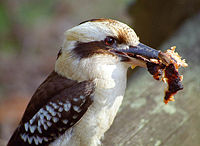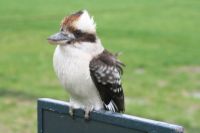Kookaburra
2008/9 Schools Wikipedia Selection. Related subjects: Birds
|
||||||||||||||||||
Kookaburras are very large, (about 17 in/43cm in height) terrestrial kingfishers native to Australia and New Guinea, the name a loanword from Wiradjuri guuguubarra, which is onomatopoeic of its call.
Kookaburras are best known for their unmistakable call, which is uncannily like loud, echoing human laughter — good-natured, if rather hysterical, merriment in the case of the well-known Laughing Kookaburra (Dacelo novaeguineae); and maniacal cackling in the case of the slightly smaller Blue-winged Kookaburra (Dacelo leachii). They are not only found in arid areas, but also in suburban and residential areas near running water and where food can be searched for easily.
Classification and species
There are four known species of Kookaburra found in Australia, New Guinea and the Aru Islands.
Unusual for close relatives, the Laughing and Blue-winged species are direct competitors in the area where their ranges overlap. This suggests that the two species, though having common stock, evolved in isolation (possibly during a period when Australia and New Guinea were more distant — see Australia-New Guinea) and were only brought back into contact in relatively recent geological times.
Postage stamps
A 6d (penny) stamp was issued in 1914.
A 38c stamp was issued around 1990 and features a pair of Kookaburras.
Yachts
The Australian 12 metre yacht Kookaburra III unsuccessfully defended the America's Cup in 1987.
Behaviour
Kookaburras are carnivorous. They will eat lizards, snakes, insects, mice and raw meat. The most social birds will accept handouts from humans and will take raw or cooked meat (even if at high temperature) from on or near open-air barbecues left unattended. It is generally not advised to feed the birds too regularly as meat alone does not include calcium and other nutrients essential to the bird. Remainders of mince on the bird's beak can fester and cause problems for the bird.
They are territorial, and often live with the partly grown chicks of the previous season. They often sing as a chorus to mark their territory.
Kookaburras, when pulled from the nest and hand fed as chicks, can make quite affectionate pets. However their captive diet of mice and beef can be difficult for some people to maintain, their noise can irritate, and they require spacious cages or aviaries to fly about in. But when all the requirements are met they are truly a worthwhile companion pet bird.
In the wild, kookaburras are known to eat babies of other birds and snakes, and insects and small reptiles. In zoos, they are usually fed food for birds of prey, and dead baby chicks.
Songs
- There is a well-known children's song about the Kookaburra.
- There is a song called "Kookaburra" by the Cocteau Twins, released on their EP Aikea-Guinea.
- There is a song called "Kookaburra" by John Vanderslice on 2007's Emerald City (album).
Olly the Kookaburra was one of the three mascots chosen for the 2000 Summer Olympics in Sydney. The other mascots were Millie the Echidna and Sydney the Platypus. Although the Kookaburra is found in only two places in the world, the distinctive sound that it makes has found its way onto many "jungle sound" soundtracks, used in movies and television as well as certain Disney park attractions no matter where in the world the action is set.
Popular culture
The Kookaburra has also had an effect on today's society. It has appeared in games such as:
- Lineage 2
- Battletoads
- World of Warcraft




